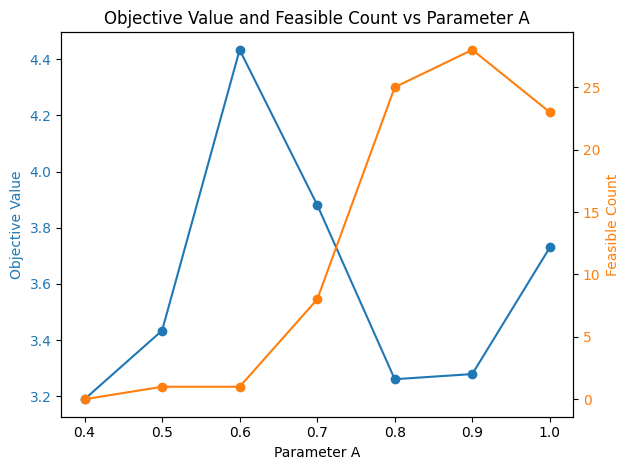QUBO’s hyper parameter search#
This notebook is a simple example of how to use MINTO to explore the hyperparameter space of a QUBO model.
For this example, we will handle the Traveling Salesman Problem with quadratic assignment formulation. For more details about the Traveling Salesman Problem, please refer to other resources.
import minto
import matplotlib.pyplot as plt
import jijmodeling as jm
import minto.problems.tsp
tsp = minto.problems.tsp.QuadTSP()
tsp_problem = tsp.problem()
n = 8
tsp_data = tsp.data(n=n)
tsp_problem
\[\begin{split}\begin{array}{cccc}\text{Problem:} & \text{QuadTSP} & & \\& & \min \quad \displaystyle \sum_{i = 0}^{n - 1} \sum_{j = 0}^{n - 1} d_{i, j} \cdot \sum_{t = 0}^{n - 1} x_{i, t} \cdot x_{j, \left(t + 1\right) \bmod n} & \\\text{{s.t.}} & & & \\ & \text{one-city} & \displaystyle \sum_{\ast_{1} = 0}^{n - 1} x_{i, \ast_{1}} = 1 & \forall i \in \left\{0,\ldots,n - 1\right\} \\ & \text{one-time} & \displaystyle \sum_{\ast_{0} = 0}^{n - 1} x_{\ast_{0}, t} = 1 & \forall t \in \left\{0,\ldots,n - 1\right\} \\\text{{where}} & & & \\& x & 2\text{-dim binary variable}\\\end{array}\end{split}\]
interpreter = jm.Interpreter(tsp_data)
instance = interpreter.eval_problem(tsp_problem)
QUBO formulation#
\[
E(x; A) = \sum_{i=0}^{n-1} \sum_{j=0}^{n-1} d_{ij} \sum_{t=0}^{n-1} x_{it} x_{j, (t+1)\mod n}
+ A \left[
\sum_i \left(\sum_{t} x_{i, t} - 1\right)^2 + \sum_t \left(\sum_{i} x_{i, t} - 1\right)^2
\right]
\]
The parameter \(A\) is a hyperparameter that controls the strength of the constraints.
In OMMX, we can tune this parameter using the .to_qubo(uniform_penalty_weight=...) method and argument uniform_penalty_weight to set the value of \(A\).
import ommx_openjij_adapter as oj_ad
parameter_values = [0.4, 0.5, 0.6, 0.7, 0.8, 0.9, 1.0]
experiment = minto.Experiment(auto_saving=False, verbose_logging=False)
for A in parameter_values:
with experiment.run() as run:
ox_sampleset = oj_ad.OMMXOpenJijSAAdapter.sample(instance, uniform_penalty_weight=A, num_reads=30)
run.log_sampleset(ox_sampleset)
run.log_parameter("A", A)
table = experiment.get_run_table()
table
| sampleset_0 | parameter | metadata | ||||||||
|---|---|---|---|---|---|---|---|---|---|---|
| num_samples | obj_mean | obj_std | obj_min | obj_max | feasible | name | A | run_id | elapsed_time | |
| run_id | ||||||||||
| 0 | 30 | 3.188953 | 0.357337 | 2.504148 | 4.075170 | 0 | 0 | 0.4 | 0 | 0.037584 |
| 1 | 30 | 3.433684 | 0.452678 | 2.613076 | 4.111693 | 1 | 0 | 0.5 | 1 | 0.030556 |
| 2 | 30 | 4.433708 | 0.624318 | 3.073818 | 5.788542 | 1 | 0 | 0.6 | 2 | 0.034105 |
| 3 | 30 | 3.881360 | 0.676330 | 2.679128 | 5.244577 | 8 | 0 | 0.7 | 3 | 0.027761 |
| 4 | 30 | 3.260340 | 0.414716 | 2.679128 | 4.173075 | 25 | 0 | 0.8 | 4 | 0.030891 |
| 5 | 30 | 3.278696 | 0.479787 | 2.679128 | 4.483248 | 28 | 0 | 0.9 | 5 | 0.031988 |
| 6 | 30 | 3.729739 | 0.748217 | 2.679128 | 6.312948 | 23 | 0 | 1.0 | 6 | 0.023222 |
fig, ax1 = plt.subplots()
# First y-axis for objective value
ax1.set_xlabel("Parameter A")
ax1.set_ylabel("Objective Value", color="tab:blue")
ax1.plot(table["parameter"]["A"], table["sampleset_0"]["obj_mean"], "-o", color="tab:blue")
ax1.tick_params(axis="y", labelcolor="tab:blue")
# Second y-axis for feasible count
ax2 = ax1.twinx()
ax2.set_ylabel("Feasible Count", color="tab:orange")
ax2.plot(table["parameter"]["A"], table["sampleset_0"]["feasible"], "-o", color="tab:orange")
ax2.tick_params(axis="y", labelcolor="tab:orange")
plt.title("Objective Value and Feasible Count vs Parameter A")
fig.tight_layout()

